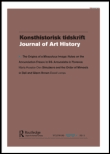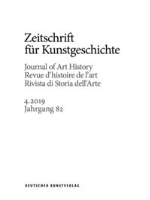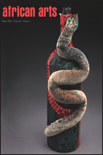
Iconographica
Scope & Guideline
Fostering Engagement Through Cultural Narratives
Introduction
Aims and Scopes
- Historical Iconography:
A primary focus of the journal is on the historical aspects of iconography, particularly in Christian art. This includes examinations of specific artworks, their contexts, and the visual language used to communicate theological and cultural narratives. - Cultural Interactions:
The journal often explores the interactions between different cultures and their artistic expressions, highlighting how iconography reflects cross-cultural exchanges, particularly in the context of the Mediterranean and European art. - Methodological Innovations:
Iconographica emphasizes methodological rigor, often incorporating interdisciplinary approaches that draw from art history, religious studies, archaeology, and cultural anthropology to analyze iconographic themes. - Materiality and Technique:
The journal also investigates the material aspects of artworks, including techniques, mediums, and their implications for understanding the production and preservation of iconographic works. - Thematic Studies:
Iconographica publishes thematic studies on specific motifs, symbols, and narratives within art, offering insights into their evolving meanings across different periods and regions.
Trending and Emerging
- Interdisciplinary Approaches:
There is an increasing trend towards interdisciplinary studies that combine iconography with fields such as anthropology, sociology, and gender studies, allowing for a more nuanced understanding of visual culture. - Contemporary Reinterpretations:
Recent papers show a growing interest in the reinterpretation of historical iconography through contemporary lenses, exploring how past images can inform current societal issues and cultural dialogues. - Digital Humanities in Iconography:
The integration of digital humanities methodologies, including digital archiving and analysis, is emerging as a significant theme, enhancing the accessibility and study of visual artifacts. - Environmental and Ethical Considerations:
A notable trend is the exploration of environmental and ethical implications in the production and representation of art, reflecting broader societal concerns about sustainability and cultural heritage. - Narrative and Storytelling in Art:
There is a rising focus on the narrative qualities of visual art, examining how stories are constructed and conveyed through iconographic elements, which enhances understanding of viewer engagement and interpretation.
Declining or Waning
- Traditional Religious Iconography:
There appears to be a declining focus on traditional interpretations of religious iconography without considering contemporary contexts or modern interpretations, indicating a shift towards more innovative and critical analyses. - Static Historical Narratives:
The journal has seen a decrease in papers that solely rely on static historical narratives without integrating broader cultural, social, or political implications, suggesting a move away from purely historical accounts. - Regional Studies:
There is a waning emphasis on region-specific studies that do not engage with transnational or global perspectives, reflecting a broader trend towards interdisciplinary and globalized approaches in art history. - Iconography of Lesser-Known Figures:
The analysis of lesser-known figures in iconography has diminished, possibly due to a growing preference for more widely recognized subjects that resonate with contemporary audiences.
Similar Journals

KONSTHISTORISK TIDSKRIFT
Advancing Critical Discourse in Visual ArtsKONSTHISTORISK TIDSKRIFT is a distinguished journal dedicated to the exploration of art history and its intersections with visual and performing arts. Published by Routledge Journals, Taylor & Francis Ltd, this esteemed publication has been a vital resource for scholars and professionals alike since its inception in 1932, with a mission to advance the understanding of historical and contemporary artistic expression. Operating from the United Kingdom, it currently occupies a commendable Q3 Quartile ranking in both History and Visual Arts and Performing Arts categories for 2023, according to Scopus metrics. With an engaging array of peer-reviewed articles, the journal serves as a platform for critical discourse, fostering an inclusive intellectual community. As it looks ahead to its convergence into 2024, KONSTHISTORISK TIDSKRIFT promises to enrich the academic landscape with impactful research and insights, making it a vital resource for researchers, professionals, and students passionate about the field.

Radovi Instituta za Povijest Umjetnosti-Journal of the Institute of Art History
Fostering Global Discourse on Art History.Radovi Instituta za Povijest Umjetnosti-Journal of the Institute of Art History is a distinguished academic journal dedicated to the exploration and critical analysis of art history, with a special emphasis on the visual arts and performing arts. Published by INST POVIJEST UMJETNOSTI-INST ART HISTORY in Croatia, this journal provides an essential platform for researchers and practitioners to disseminate their findings and engage in scholarly discourse. Since its transition to Open Access in 2008, it has significantly increased the accessibility of its content, fostering a global exchange of ideas. The journal is indexed in notable databases, reflecting its impact within its field, with a current ranking that places it in the Q4 category for History and in Q3 for Visual Arts and Performing Arts. As it spans its converged years from 2015 to 2024, Radovi is poised to expand its influence and continue contributing to the understanding of art historical narratives. Researchers, professionals, and students alike will find this journal a valuable resource for contemporary discussions and theoretical advancements in the study of art.

ARCHIVO ESPANOL DE ARTE
Celebrating the Intersection of Art and AcademiaARCHIVO ESPANOL DE ARTE is a distinguished journal dedicated to the exploration and dissemination of research in the fields of visual arts and performing arts. Published by CONSEJO SUPERIOR INVESTIGACIONES CIENTIFICAS-CSIC in Spain, this journal has been an open access publication since 1996, facilitating unrestricted access to valuable scholarly content for researchers, professionals, and students alike. With an E-ISSN of 1988-8511 and a commitment to covering a range of artistic phenomena, it plays a significant role in advancing the understanding and appreciation of art within both academic and cultural contexts. Although currently categorized in the Q4 quartile within its discipline, its ranking within Scopus—at #400/667, placing it in the 40th percentile—reflects its contributions to the broader discourse in art research. The journal's suite of open access offerings ensures that cutting-edge research remains accessible, fostering collaboration and innovation in the ever-evolving landscape of the arts.

Artibus et Historiae
Cultivating Knowledge in the Arts and HumanitiesArtibus et Historiae is a distinguished academic journal published by IRSA PUBLISHING HOUSE, focusing on the fields of Visual Arts and Performing Arts within the broader scope of Arts and Humanities. With an ISSN of 0391-9064, this journal has become a crucial platform for the dissemination of scholarly research, critical discourse, and innovative ideas in art history and visual culture. Though its coverage in Scopus was discontinued in 2018, it maintained a respectable ranking of #279 out of 502 in its category, placing it in the 44th percentile. This positions Artibus et Historiae as a respected contributor to scholarly conversations in its field. Researchers, professionals, and students will find valuable insights and analyses that deepen their understanding of artistic practices and historical contexts. While not an open-access journal, it aims to bridge the gap between academia and broader audiences interested in the dynamic interplay of art and history.

RIHA Journal
Cultivating a vibrant community of art scholars.RIHA Journal, an esteemed publication in the field of Visual Arts and Performing Arts, is published by the RIHA-INT ASSOC RESEARCH, INST HISTORY ART in Germany. Since its inception in 2010, this Open Access journal has aimed to foster scholarly discussion and dissemination of research within art history and related disciplines. With a commitment to providing a platform for innovative and interdisciplinary approaches, RIHA Journal is easily accessible to a global audience, encouraging researchers, professionals, and students alike to engage with cutting-edge scholarship. Despite its current position within the Q4 category and a Scopus rank of #402 out of 667, the journal's role is increasingly pivotal as it continues to expand its reach and impact within the academic community. Located at the Central Institute for Art History in Munich, Germany, RIHA Journal is dedicated to enriching the study of art history from 2010 to 2024 and beyond, paving the way for future explorations and discussions in the visual arts.

Umeni-Art
Advancing Knowledge in the Visual and Performing ArtsUmeni-Art is a prominent journal in the field of visual arts and performing arts, published by the Institute of Art History, Academy of Sciences, Czech Republic. With its ISSN 0049-5123 and E-ISSN 1804-6509, the journal has established itself as a critical platform for scholarly discourse and artistic expression since its inception in 2002. Although currently classified in Q4 within the Arts and Humanities category, it aims to elevate the understanding and appreciation of the arts through rigorous research and innovative perspectives. The journal's Scopus ranking places it at Rank #573/667, reflecting its growing contribution to the field and expanding reach within the artistic community. With a focus on fostering collaboration among researchers, practitioners, and students, Umeni-Art seeks to enrich the academic landscape with significant findings and discussions that inspire future research and creative endeavors. While it does not offer open access, the journal remains a valuable resource for those vested in exploring the dynamic interplay between art, culture, and society in the contemporary context.

REVUE DE L ART
Fostering Interdisciplinary Insights in Art ScholarshipREVUE DE L'ART, published by EDITIONS C N R S, is a significant scholarly journal that focuses on the diverse realms of visual arts and performing arts. With an ISSN of 0035-1326, the journal serves as a vital forum for researchers, professionals, and students, engaging them in contemporary discourses surrounding artistic practices and critical theories. While it currently holds a Q4 ranking in the Visual Arts and Performing Arts category for 2023, with a Scopus ranking of #578 out of 667, REVUE DE L'ART emphasizes the importance of innovative research and interdisciplinary studies in the arts. Although it is not an open access publication, the journal ensures that high-quality scholarship remains accessible to professionals and student communities in France and beyond. The journal’s commitment to artistic investigation and analysis continues to contribute significantly to the understanding of art within historical and contemporary contexts, making it a crucial resource for anyone engaged in these fields.

ZEITSCHRIFT FUR KUNSTGESCHICHTE
Illuminating Visual Narratives and Performative ExpressionsZEITSCHRIFT FUR KUNSTGESCHICHTE is a prestigious journal dedicated to the study of art history, offering insightful analyses and discussions that enrich the understanding of visual arts and performing arts. Published by DEUTSCHER KUNSTVERLAG GMBH in Germany, this journal has established itself as a significant platform for researchers and professionals alike since its inception. With a print ISSN of 0044-2992 and an e-ISSN of 2569-1619, it spans a comprehensive range of topics in art history, reflecting both traditional and contemporary perspectives. Although categorized in the Q4 quartile for Visual Arts and Performing Arts, the journal contributes to a rich dialogue within its field, aiming to foster academic discourse and promote scholarly research. Its scope has evolved notably from converged years starting in 1975 and gathering strength from 2001 to 2024, and it is committed to serving as an essential resource for students, academics, and practitioners in the arts. While not offering open access, the journal maintains a rigorous peer-review process to ensure high-quality submissions that advance knowledge and stimulate critical thought.

Boletin de Arte-UMA
Connecting Scholars to the Pulse of Artistic InnovationBoletin de Arte-UMA is a distinguished academic journal published by the University of Malaga, Department of History of Art, focusing on the rich interplay between history, visual arts, and performing arts. Operating under an Open Access model since 2013, this journal ensures that valuable research is freely available for scholars and practitioners worldwide. With an impact factor currently reflecting its academic rigor through its Q2 ranking in History and Q1 ranking in Visual Arts and Performing Arts, Boletin de Arte-UMA serves as a vital platform for cutting-edge research, critical analysis, and the promotion of cultural heritage studies. Based in Malaga, Spain, the journal not only provides insights into its thematic scope but also fosters a global dialogue among researchers, professionals, and students passionate about the visual and performing arts.

AFRICAN ARTS
Exploring the Vibrancy of African CreativityAFRICAN ARTS is a distinguished journal published by MIT PRESS, focusing on the vibrant intersections of literature, visual arts, and performing arts within the African context. Boasting an ISSN of 0001-9933 and an E-ISSN of 1937-2108, this journal serves as a critical platform for scholars and practitioners worldwide to explore and disseminate their research on African artistic expressions. With a solid impact represented by its Q3 rankings in both Literature and Literary Theory and Visual Arts and Performing Arts as of 2023, it ranks in the top 20% within the literature category and in the top 30% for visual arts. AFRICAN ARTS aims to foster a deeper understanding of the cultural, historical, and social contexts that shape these disciplines, embracing a wide array of methodologies and theoretical frameworks. Though not an open-access journal, it provides valuable insights and analysis that contribute significantly to the global discourse surrounding African arts, making it a vital resource for researchers, professionals, and students alike.